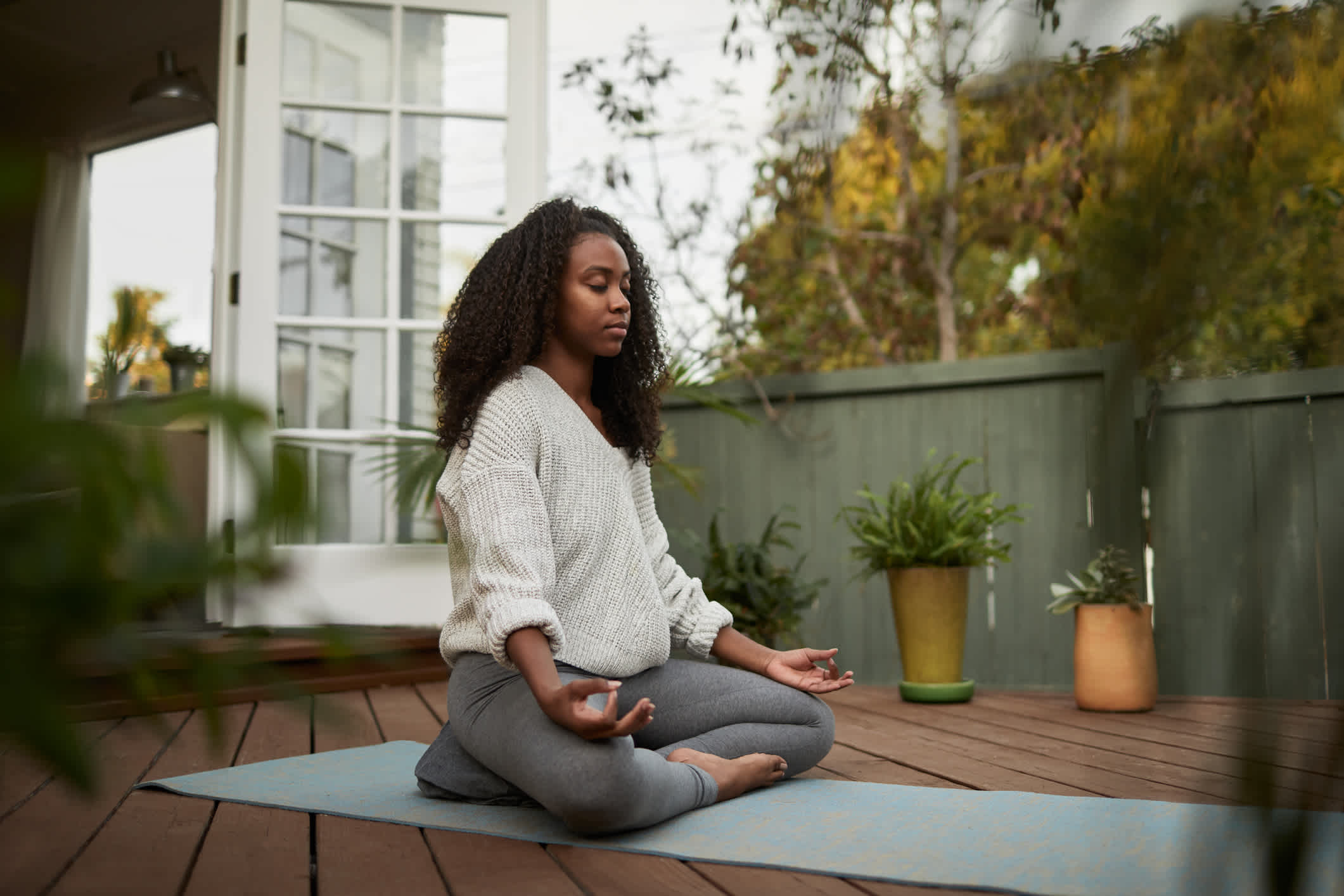6 Meditation Tips to Reduce Your Stress and Chronic Pain
Let’s take a deeper dive into what meditation is, how it can help with managing stress, and ultimately, reduce chronic pain.
- Hinge Health Learning Center
- Articles
- 6 Meditation Tips to Reduce Your Stress and Chronic Pain
Our Hinge Health Experts
Terri Finney, NBC-HWC
Meditation is a useful technique that I employ to help my Hinge Health participants minimize their stress levels as part of our holistic approach to reducing chronic back and joint pain. According to research, stress and mental health issues are common underlying drivers of chronic back and joint pain. In fact, studies show incorporating meditation techniques as part of the treatment of chronic back and joint conditions helps decrease pain over the long-term.
As a health coach at Hinge Health, I work with people suffering from chronic back and joint pain and help them make key lifestyle changes that can alleviate their pain. For example, I worked with Vera, a Hinge Health participant, to help her manage her knee pain by doing different forms of meditation in addition to her Hinge Health exercise therapy program.
Vera applied to the Hinge Health Knee Program because she wanted relief from pain caused by a previously torn meniscus. From the very beginning of her program, she committed to doing it at least 3 days per week, but often did more. She was feeling good about her progress and started noticing positive changes in her body and pain response. However, she was worried it wouldn’t last because of her demanding work hours. We brainstormed ways to work on mindfulness and stress reduction practices, so she could balance her work and life better. She started implementing deep breathing, meditation, additional gentle stretching, and yoga into her weekly routine. Not only did the strategies help reduce the stress in her life, it also helped her body to relax. In turn, her pain lessened because she was calm, focused, able to relax, and moving more. All of this allowed her to accomplish more with less time.
You and your members can also take advantage of meditation as a technique to reduce both stress and chronic back and joint pain. Let’s take a deeper dive into what meditation is, how it can help with managing stress, and ultimately, reduce chronic pain. In this blog, I will share the health benefits of meditation and 6 tips to get started.
What is meditation?
Here is a simple but thorough explanation of what meditation is from VeryWellMind:
“Meditation can be defined as a set of techniques that are intended to encourage a heightened state of awareness and focused attention. Meditation is also a consciousness-changing technique that has been shown to have a wide number of benefits on psychological well-being.”
Six most common types of meditation
Because meditation originated in several different countries such as India, China, and Japan, there are several different methods of meditating. Here are some of the most popular practices today:
Mindfulness meditation - Observe thoughts and thought patterns with curiosity and without judgement. This might include paying attention to your breath and bodily sensations.
Spiritual meditation - Connect more deeply to your higher self, divine oneness, the universe, God, etc., through personal reflection and/or prayer.
Focused meditation - One or all of the 5 senses are involved. You might listen to nature sounds, focus your vision on something in the room, or hold an object in your hands.
Movement meditation - Yoga, Tai Chi, and walking meditations are good examples of movement meditations. The movement keeps your mind focused on the moment.
Mantra meditation - The use of repetitive sound is used in this meditation. This is where people may use the chant “Om”. You can make up whatever sound or word you want though.
Transcendental meditation - This is similar to the mantra meditation in that it includes chanting. It may be one word or a series of words.
I tend to gravitate toward focused or movement meditations although I’ve been known to try my hand at mantra meditation before. I prefer the action-oriented meditations because I find I have an easier time staying focused that way. When I meditate, you’ll either find me doing yoga outside on the patio or in bed at night using guided meditations via Insight Timer. No matter what type I do, I find it makes me feel more relaxed which makes it easier to sleep among other things. According to the National Center for Complementary and Integrative Health, there are a lot of benefits associated with meditation in addition to relaxation and improved sleep. Let’s take a deeper dive into it.
The benefits of meditation
It has been associated with decreasing the body’s pain response - A few studies from 2013 and 2016 show that implementing some type of stress reduction or thought management strategies into a treatment plan for chronic pain decreased pain over the long term compared to conventional treatments.
It has been associated with decreasing anxiety and depression - Two different studies from 2012 and 2014 found that symptoms of anxiety and depression were decreased when meditation was implemented.
It has been associated with lowering blood pressure - Scientific literature supports using meditation to lower blood pressure in those who are at risk of developing high blood pressure.
It has been associated with a decrease in digestive distress symptoms with IBS - This study shows a substantial positive effect on digestive distress symptoms in those with IBS.
It has been associated with tobacco cessation - This study suggests that meditation can help people improve self-control, therefore, decrease cravings for tobacco.
It has been associated with improved sleep - The Annals of the New York Academy of Sciences found that meditation may be effective in treating some types of sleep disturbances.
It has been estimated that 200-500 million people worldwide meditate. If you’ve been thinking about starting your own meditation practice, but haven’t committed to the idea yet or are unsure where to begin, here are 6 tips to get started.
6 meditation tips to start your own practice
1. Get cozy. If you are in a business suit , it’s going to feel different than if you are in sweat pants and a t-shirt when it comes to feeling relaxed for meditation. If you can’t get into cozy clothing because you are at work in your business attire, do what you can to get comfortable. That may include unbuttoning a few buttons, taking off your shoes, taking off your tie, or letting your hair down.
2. Create a time and space for your practice. Maybe you start with 2 minutes sitting on your back deck focusing on the sounds of nature or go to a quiet spot in your home and use guided imagery. No matter where you choose to do it, it works best to choose a location free from distractions and to also create a consistent routine if you can. If you can’t find a distraction-free zone in your house, you can do it while cleaning the house!
3. Practice doing a movement meditation. A movement meditation can be yoga, Tai Chi, and walking, but it can also be done in much simpler ways. You can consider every move you make a part of the meditation. Maybe that’s sweeping the hair off your shoulders, sitting cross legged, touching your hands to your legs while sitting, or picking up a book to read. Instead of doing it mindlessly, take the moment to truly be present in what you are doing.
4. Experiment with different types of meditation. You may find that one way works better for you than another or you choose what to do based on your mood. See my above list on the different types of meditation. I mostly do bedtime meditations, but find that quick morning ones can set my day up positively.
5. Start with a small time commitment. You can begin with a 1-minute meditation or 1 hour. Either way, it’s up to you. I find with any new routine it’s easier to implement when you start with a smaller time commitment and then increase from there.
6. Pay attention to your breathing. Many times throughout the day we may find that we have rapid, shallow breaths. By focusing on your breathing, you are more likely to get more oxygen and feel more relaxed. Take a deep breath, pause, and then let it out slowly. Try to continue this pattern during the meditation. For more on breathing techniques, read blog: 7 Daily Breathing Exercises to a Stress-free and Healthier Life.
If you are unsure if meditation is right for you, please consult your coach, therapist, doctor, or other healthcare practitioner. If you feel ready and excited to try it, create your own practice or try this 10-minute guided meditation. You can be sitting or lying down for this. Do what feels best for you. Enjoy!
Through virtual 1-on-1 physical therapists & clinicians, behavioral health coaches, and sensor technology, Hinge Health offers a holistic approach to reducing chronic back and joint pain from the comfort of your home. If you are an employee, ask your employer or health plan if they offer Hinge Health. If you are an employer or health plan, find out how Hinge Health’s virtual clinical care model and Digital MSK Clinic drives long-term member outcomes by requesting a demo below.

